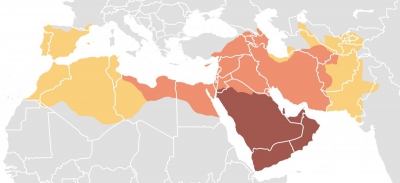The abolition of the Ottoman Sultanate (Turkish: Saltanatn kaldrlmas) by the Grand National Assembly of Turkey on 1 November 1922 ended the Ottoman Empire, which had lasted since 1299. On 11 November 1922, at the Conference of Lausanne, the sovereignty of the Grand National Assembly exercised by the Government in Angora (now Ankara) over Turkey was recognized. The last sultan, Mehmed VI, departed the Ottoman capital, Constantinople (now Istanbul), on 17 November 1922. The legal position was solidified with the signing of the Treaty of Lausanne on 24 July 1923. In March 1924, the Caliphate was abolished, marking the end of Ottoman influence.
A caliphate or khilāfah (Arabic: خِلَافَة, Arabic pronunciation: [xi'laːfah]) is an institution or public office governing a territory under Islamic rule. The person who holds this office carries the title of caliph (; Arabic: خَلِيفَة Arabic pronunciation: [xæ'liː'fæh], pronunciation ) and is considered a politico-religious successor to the Islamic prophet Muhammad and a leader of the entire Muslim world (Ummah). Historically, the caliphates were polities based on Islam that developed into multi-ethnic trans-national empires.While the importance of the Caliphate as a political power fluctuated throughout the history of Islam, the institution survived for over a thousand years. Often acting as little more than a symbolic figurehead, the formal office of Caliph remained from the death of Muhammad in 632 until the Ottoman Caliphate was formally dismantled in 1924. During the medieval period, three major caliphates succeeded each other: the Rashidun Caliphate (632–661), the Umayyad Caliphate (661–750), and the Abbasid Caliphate (750–1517). In the fourth major caliphate, the Ottoman Caliphate, the rulers of the Ottoman Empire claimed caliphal authority from 1517 and maintained Sunni Islam as the official religion. A few other Muslim states, almost all hereditary monarchies, such as the Abbasid caliphs under protection of the Mamluk Sultanate (Cairo) and the Ayyubid Caliphate, have claimed to be caliphates. The first caliph was Abu Bakr and the last caliph was Abdulmejid II.
The first caliphate, the Rāshidun Caliphate, immediately succeeded Muhammad after his death in 632. The four Rāshidun caliphs were chosen through shura, a process of community consultation that some consider to be an early form of Islamic democracy. The fourth caliph, Ali, who, unlike the prior three, was from the same clan as Muhammad (Banu Hāshim), is considered by Shia Muslims to be the first rightful caliph and Imam after Muhammad. Ali reigned during the First Fitnā (656–661), a civil war between supporters of Ali and supporters of the assassinated previous caliph, Uthman, from Banu Umayya, as well as rebels in Egypt; the war led to the establishment of the Umayyad Caliphate under Muāwiyah I in 661.
The second caliphate, the Umayyad Caliphate, was ruled by Banu Umayya, a Meccan clan descended from Umayya ibn Abd Shams. The caliphate continued the Arab conquests, incorporating the Caucasus, Transoxiana, Sindh, the Maghreb and the Iberian Peninsula (Al-Andalus) into the Muslim world. The caliphate had considerable acceptance of the Christians within its territory, necessitated by their large numbers, especially in the region of Syria. Following the Abbasid Revolution from 746 to 750, which primarily arose from non-Arab Muslim disenfranchisement, the Abbāsid Caliphate was established in 750.
The third caliphate, the Abbāsid Caliphate was ruled by the Abbāsids, a dynasty of Meccan origin descended from Hāshim, a great-grandfather of Muhammad, via Abbās, an uncle of Muhammad. Caliph al-Mansur founded its second capital of Baghdād in 762, which became a major scientific, cultural and art centre, as did the territory as a whole, during the period known as the Islamic Golden Age. From the 10th century, Abbasid rule became confined to an area around Baghdad and saw several occupations from foreign powers. In 1258, the Mongol Empire sacked Baghdad, ending the Abbasid rule over Baghdad, but in 1261 the Mamluks in Egypt re-established the Abbasid Caliphate in Cairo. Though lacking in political power, the Abbasid dynasty continued to claim authority in religious matters until the Ottoman conquest of Mamluk Egypt in 1517, which saw the establishment of the Ottoman Caliphate.A few other states that existed through history have called themselves caliphates, including the Ayyubid Caliphate during the reign of Saladin (1174–1193), Isma'ili Fatimid Caliphate in Northeast Africa (909–1171), the Umayyad Caliphate of Córdoba in Iberia (929–1031), the Berber Almohad Caliphate in Morocco (1121–1269), the Fula Sokoto Caliphate in present-day northern Nigeria (1804–1903), and the Islamic State of Iraq and the Levant in the 2010s.
The Sunni branch of Islam stipulates that, as a head of the Ummah (Islamic world), a caliph was a selected or elected position. Followers of Shia Islam however, believe in an Imamate rather than a Caliphate, that is to say a caliph should be an Imam chosen by Allah from the Ahl al-Bayt (the "Family of the House", Muhammad's direct descendants).

1924Mar, 3
The fourteenth-century Islamic caliphate is abolished when Caliph Abdülmecid II of the Ottoman Empire is deposed. The last remnant of the old regime gives way to the reformed Turkey of Kemal Atatürk.
Choose Another Date
Events on 1924
- 12Feb
Rhapsody in Blue
George Gershwin's Rhapsody in Blue received its premiere in a concert titled "An Experiment in Modern Music", in Aeolian Hall, New York, by Paul Whiteman and his band, with Gershwin playing the piano. - 25Mar
Second Hellenic Republic
On the anniversary of Greek Independence, Alexandros Papanastasiou proclaims the Second Hellenic Republic. - 8Apr
Atatürk's Reforms
Sharia courts are abolished in Turkey, as part of Atatürk's Reforms. - 4Aug
Soviet Union
Diplomatic relations between Mexico and the Soviet Union are established. - 23Nov
Andromeda Galaxy
Edwin Hubble's discovery, that the Andromeda "nebula" is actually another island galaxy far outside of our own Milky Way, is first published in The New York Times.

 English
English  español
español  français
français  português
português  русский
русский  العربية
العربية  简体中文
简体中文 